
Christ, used by Christians as both a name and a title, unambiguously refers to Jesus. It is also used as a title, in the reciprocal use "Christ Jesus", meaning "the Messiah Jesus" or "Jesus the Anointed", and independently as "the Christ". The Pauline epistles, the earliest texts of the New Testament, often refer to Jesus as "Christ Jesus" or "Christ".

The nativity of Jesus, nativity of Christ, birth of Jesus or birth of Christ is described in the biblical gospels of Luke and Matthew. The two accounts agree that Jesus was born in Bethlehem in Judaea, that his mother, Mary, was engaged to a man named Joseph, who was descended from King David and was not his biological father, and that his birth was caused by divine intervention. Many modern scholars consider the birth narratives unhistorical because they are laced with theology and present two different accounts which cannot be harmonised into a single coherent narrative. However, many others view the discussion of historicity as secondary, given that gospels were primarily written as theological documents rather than chronological timelines.

The patella, also known as the kneecap, is a flat, rounded triangular bone which articulates with the femur and covers and protects the anterior articular surface of the knee joint. The patella is found in many tetrapods, such as mice, cats, birds and dogs, but not in whales, or most reptiles.
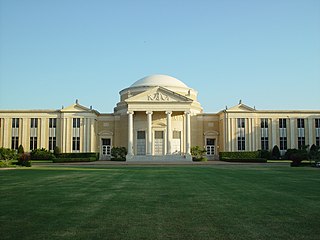
A seminary, school of theology, theological seminary, or divinity school is an educational institution for educating students in scripture and theology, generally to prepare them for ordination to serve as clergy, in academics, or mostly in Christian ministry.
Semi-Pelagianism is a Christian theological and soteriological school of thought about the role of free will in salvation. In semipelagian thought, a distinction is made between the beginning of faith and the increase of faith. Semi-Pelagian thought teaches that the latter half – growing in faith – is the work of God, while the beginning of faith is an act of free will, with grace supervening only later. Semi-Pelagianism in its original form was developed as a compromise between Pelagianism and the teaching of Church Fathers such as Saint Augustine. Adherents to Pelagianism hold that people are born untainted by sin and do not need salvation unless they choose to sin, a belief which had been dismissed as heresy. In contrast, Augustine taught that people cannot come to God without the grace of God. Like pelagianism, semipelegianism was labeled heresy by the Western Church at the Second Council of Orange in 529.

The quadriceps femoris muscle is a large muscle group that includes the four prevailing muscles on the front of the thigh. It is the sole extensor muscle of the knee, forming a large fleshy mass which covers the front and sides of the femur. The name derives from Latin four-headed muscle of the femur.

Jesus, also referred to as Jesus Christ, Jesus of Nazareth, and many other names and titles, was a first-century Jewish preacher and religious leader. He is the central figure of Christianity, the world's largest religion. Most Christians believe Jesus to be the incarnation of God the Son and the awaited Jewish messiah, the Christ that is prophesied in the Hebrew Bible.
Alban Butler was an English Roman Catholic priest and hagiographer.
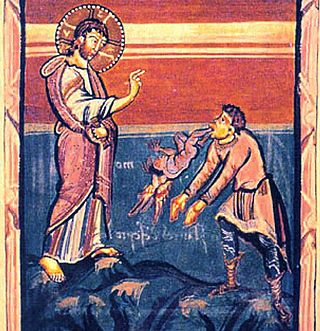
Legion means a large group or in another parlance it may mean "many". In the Christian Bible, it is used to refer to the group of demons, particularly those in two of three versions of the exorcism of the Gerasene demoniac, an account in the New Testament of an incident in which Jesus performs an exorcism.

The baptism of Jesus by John the Baptist is a major event in the life of Jesus which is described in the three synoptic Gospels of the New Testament, in which John baptized Jesus with water to fulfill all righteousness. Jesus Christ who is God in His essence cannot be purified either realistically or ritually, so His baptism is according to Jesus to "fulfill all righteousness". He said to John the Baptist “Permit it to be so now, for thus it is fitting for us to fulfill all righteousness”. The word "thus" in English is "hutos" in Greek which means "in this way", "in most appropriate way", "in no other way but this". And righteousness which is "dikaiosune" in Greek means the "fairest state that has no defect at all", "fairness and justice". So it was to fulfill God's righteouness that John baptized Him and Jesus was to receive His baptism. It is considered to have taken place at Al-Maghtas, today located in Jordan.
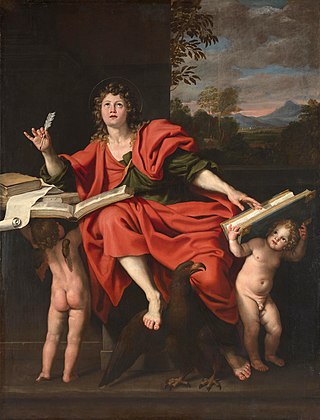
Johannine literature is the collection of New Testament works that are traditionally attributed to John the Apostle, John the Evangelist, or to the Johannine community. They are usually dated to the period c. AD 60–110, with a minority of scholars such as John AT Robinson offering the earliest of these datings.

John Michael Talbot is an American Christian musician, author, television presenter and founder of a monastic community known as the Brothers and Sisters of Charity.
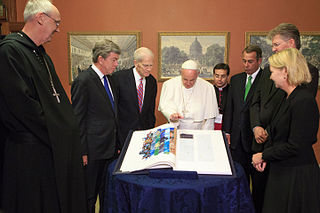
The Saint John's Bible is the first completely handwritten and illuminated Bible to be commissioned by a Benedictine abbey since the invention of the printing press. The project was headed by Donald Jackson, and work on the manuscript took place in both Wales and Minnesota. Work on the 1,100 page Bible began in 1998 when it was commissioned by the Benedictine monks at Saint John's University, and was completely finished in December 2011 at a total cost of over $8 million. The Saint John's Bible is divided into seven volumes and is two feet tall by three feet wide when open. The book is written on vellum by quill, containing 160 illuminations across its seven volumes, and uses the New Revised Standard Version Catholic Edition (NRSV-CE) of the Bible. A copy of The Saint John's Bible has been presented to the Pope at the Vatican in several volumes, with the final volume presented on April 17, 2015.

Symbolism of Christian saints has been used from the very beginnings of the religion. Each saint is said to have led an exemplary life and symbols have been used to tell these stories throughout the history of the Church. A number of Christian saints are traditionally represented by a symbol or iconic motif associated with their life, termed an attribute or emblem, in order to identify them. The study of these forms part of iconography in art history. They were particularly used so that the illiterate could recognize a scene, and to give each of the Saints something of a personality in art. They are often carried in the hand by the Saint.

In Christian theology, the imitation of Christ is the practice of following the example of Jesus. In Eastern Christianity, the term life in Christ is sometimes used for the same concept.
Luke Timothy Johnson is an American New Testament scholar and historian of early Christianity. He is the Robert W. Woodruff Professor of New Testament and Christian Origins at Candler School of Theology and a Senior Fellow at the Center for the Study of Law and Religion at Emory University.
Mark Stratton John Matthew Smith is an American biblical scholar, anthropologist, and professor.

Patella ulyssiponensis, common name the rough limpet, or China limpet is a species of sea snail, a true limpet, a marine gastropod mollusk in the family Patellidae, one of the families of true limpets. Despite its common name, the China limpet is found throughout the Eastern North Atlantic and the Mediterranean.
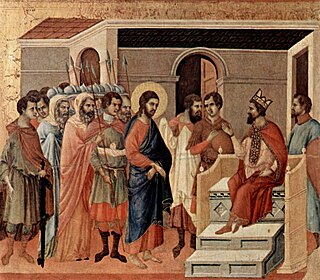
Jesus at Herod's court refers to an episode in the New Testament which describes Jesus being sent to Herod Antipas in Jerusalem, prior to his crucifixion. This episode is described in the Gospel of Luke.













